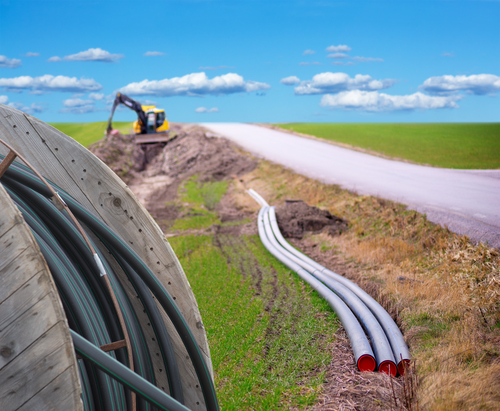GRID Broadband Act seeks to build out middle-mile infrastructure along existing electric grid

Two United States senators recently proposed bipartisan legislation that would provide new federal cost-share grants to spur investment in a nationwide middle-mile backbone along America’s existing electricity grid.
“Almost a century ago, the Rural Electrification Act helped bring power and productivity to every American home and business,” said U.S. Sen. Maria Cantwell (D-WA), who sponsored the Grants to Rapidly Invest and Deploy (GRID) Broadband Act of 2022, S. 4763.
“Now we can piggyback on that success by using the same network to also deliver the data and information America needs to prosper in this century,” said Cantwell, who was joined by lead original cosponsor U.S. Sen. Shelley Moore Capito (R-WV) in introducing the measure.
If enacted, S. 4763 would fund resilient and redundant middle-mile, fiber-optic infrastructure to provide more opportunity for last-mile providers to connect to unserved and underserved locations in urban, rural and remote areas with high-quality, high-speed broadband, according to the text of the bill.
Middle-mile infrastructure connects network hubs with the retail networks — known as last-mile infrastructure — that directly serve homes and businesses. These are vital links, the lawmakers said, because last-mile broadband speed and reliability is dependent on the middle-mile infrastructure that serves it.
“The GRID Broadband Act would utilize our nation’s electric grid system to help build out and deploy broadband, especially in some of the most rural areas of West Virginia with little to no service,” added Capito, who called the bill “a triple win solution for consumers” because it leverages existing rights-of-way and private-sector ingenuity and investment to deliver cleaner electricity, stronger cybersecurity, and more accessible broadband services.
Additionally, the bill would enhance the grid security to guarantee power is delivered to critical facilities and electricity-dependent essential services, and seeks to reduce restoration time following power disturbances, according to the bill.
Consumers also stand to benefit. According to data provided by Microsoft, roughly 120 million Americans do not have access to affordable, high-speed internet, and according to a Pew Research study, 45 percent of Americans without broadband access cited price among the reasons they did not have broadband service.
To rectify such challenges, S. 4763 also would permanently reduce the cost of high-speed broadband across the United States, including for low-income households and small businesses, among other provisions in the bill.
At the same time, the new investments under the bill also would create thousands of skilled jobs, the senators said, setting the stage for sustained long-term economic growth.
Tom Kuhn, president of the Edison Electric Institute (EEI), which represents the nation’s investor-owned utilities, commended the lawmakers for prioritizing fiber investments that he said will help close the digital divide.
“The GRID Broadband Act will provide resources to help accelerate the deployment of fiber that will provide additional flexibility to grid operators in the event of extreme weather,” said Kuhn. “It will also improve cybersecurity and resilience, and will help with the further integration of renewable and energy storage technologies.”
Specifically, the measure would task the U.S. Commerce Department’s National Telecommunications and Information Administration with issuing competitive cost-share federal grants to encourage the development of the nationwide broadband backbone on existing electric grid infrastructure.
Grant recipients must use the funding to improve cybersecurity and smart grid technology on their electrical grid infrastructure, as well as increase middle-mile broadband capacity, and they must cover at least half of project costs, except for a qualifying not-for-profit utility or Native entity that is providing access to underserved or unserved communities.
In addition to EEI, the GRID Broadband Act has garnered support from a broad coalition of public and private utilities and public interest groups, including the National Rural Electric Cooperative Association (NRECA), the Utilities Technology Council (UTC), Public Knowledge, and the Washington Public Utility Districts Association, among others.
“Building out middle-mile broadband infrastructure is a critical step that will serve two important purposes: enhancing the resiliency of the electric grid and connecting rural communities to high-speed internet service,” said Louis Finkel, NRECA’s senior vice president. “These efforts are crucially important as the American economy increasingly relies on electricity and web-based businesses to fuel the future.”
UTC President and CEO Sheryl Osiene-Riggs called the proposed bill a catalyst for urgently needed middle-mile deployment by electric utilities.
“By funding utility fiber deployment, the GRID Broadband Act will support utility operations and promote broadband access, which will stimulate new economic growth opportunities for unserved and underserved communities,” said Osiene-Riggs. “I believe that this legislation will facilitate the high-capacity infrastructure required to support robust, sustainable, and affordable connectivity for grid modernization and zero carbon initiatives, broadband access, as well as 5G/6G backhaul.”
